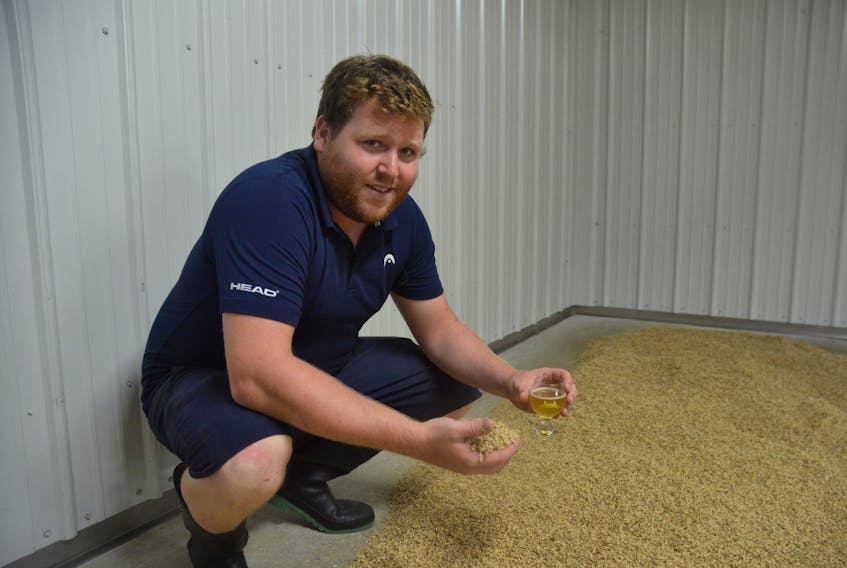HORTONVILLE, NS - Horton Ridge is carving out quite a niche in the Atlantic Canadian craft brewing industry.
Horton Ridge Malt and Grain Company maltster and assistant brewer Connor Stewart said construction on the malt house began in May 2014 and started using various grains to produce malt the following year. A tap room opened in June 2017.
Some people are surprised to find a tap room at the malt house - easily spotted when travelling west on Highway 101 - but Stewart says a lot of tourists are visiting, in part, thanks to referrals from local wineries.

The Hortonville resident said the taproom uses Horton Ridge's own malt exclusively in brewing the house beer sold in the tap room, a process Stewart refers to as “from grain to glass.” Producing its own malt makes Horton Ridge rather unique, he adds.
“We’re like the winery of the craft brew industry because we’re the only one (producing malt) in Atlantic Canada as it stands,” Stewart says.

Farming innovation
Stewart's father, Alan, has always been an organic farmer and was looking for a project involving grain other than producing animal feed. With the craft brewery market growing, he decided to give malting grains a go.
Horton Ridge acts as a sort of “middleman” between the farmer and brewery, taking various organically-grown grains and malting them for use in the brewing process.
“We grow some of the grain - we’re growing rye, wheat and barley this year - but when we first started this project, no one was growing the grain that we needed, so we had to go to Saskatchewan,” Stewart said.

The goal, he says, is to malt 100 per cent Atlantic Canadian grain. And it appears Horton Ridge may reach this point faster than anticipated. This year, approximately 50 per cent of the grain Horton Ridge is malting comes from PEI, and Stewart expects that percentage to increase next year.
As a craft brewery, Horton Ridge is about as small as it gets. Most of the malt produced is shipped out for use by other breweries, with Big Spruce Brewing, Tatamagouche Brewing Company and the Annapolis Brewing Company currently the top three customers.
Big Spruce and Tatamagouche are both organic brewers, so Horton Ridge malt is a good fit for them, Stewart says. There are distilleries using the malt to produce whiskey but, since it takes three to five years to age, there isn’t any available on the market yet.

READ MORE:
- Crafting a new future for beer in the Annapolis Valley
- ‘It’s a labour of love’: Pioneering brewer reflects on success at Sea Level in Port Williams
- Head of the class: Ellershouse man passionate about creating the beer behind Schoolhouse Brewery
- From farm to bottle: Sourcing local hops a challenge for Annapolis Valley brewers
- ‘A disadvantage in our own market’: Craft beer brewer association president says Nova Scotia brewers hit with unfair tax
- Source your Annapolis Valley craft beer
The process
It all starts when the grain arrives from the originating farms in large, 2,750-pound tote bags. The grain is run through a cleaner, then steeped in water in a controlled, two-day process that includes air rests. The grain is then allowed to germinate on the floor, growing agrospires.
After about five days, when the agrospires reach the full length of the grain and it has been raked to help cool it down and to break up the rootlets, it goes into a wood pellet-fired kiln for about a day and a half to dry. The rootlets are then removed and the malted grain is packed in 25-kilogram bags for shipping.
“It takes about six or seven days for a batch, but we do two or three at a time,” Stewart said.
Horton Ridge is currently producing almost 150 tonnes of malt annually. To put that in perspective, at Horton Ridge, one 25 kg bag of malt is used in each batch of beer brewed for the tap room.
Stewart said this is quite a lot considering the size of the operation - but compared to other larger industrial producers, it's only a drop in the bucket.

Similar to grapes grown in a specific region, Stewart said Horton Ridge's malted grains feature a certain terroir and add character to beers. At the industrial level, he said, almost all of the flavour has been lost from base malts. Smaller percentages of other malts are usually added to give a brew a certain taste.
The Horton Ridge malt is rich in flavour and Stewart has found have to do less in the brewing process to produce a good beer because of it.
He’s learned a lot about both malting and brewing over the past couple of years, giving him a greater appreciation of the work that has gone into it when he enjoys a beer at the bar.
Stewart has enjoyed meeting other brewers and learning from them, including what they think of the malt and how they use it.
“There’s a lot to think about,” he said. “There are more styles of beers than I ever thought and there’s also probably five different ways you can make each style.”

Did you know?
Connor Stewart says there are probably 20 to 30 kinds of malt that Horton Ridge isn’t able to produce yet because of the temperatures involved. Roasting grains longer, at a higher temperature, brings out more flavour and allows the production of different varieties of malt.
Some of the malts that Horton Ridge currently produces include Munich, Vienna, Pale Ale, Pilsner, Apple Malt (to make Apple Sour), Pale Two Row (a base malt, what Horton Ridge currently sells the most of), Wheat, Rye and Oats.









